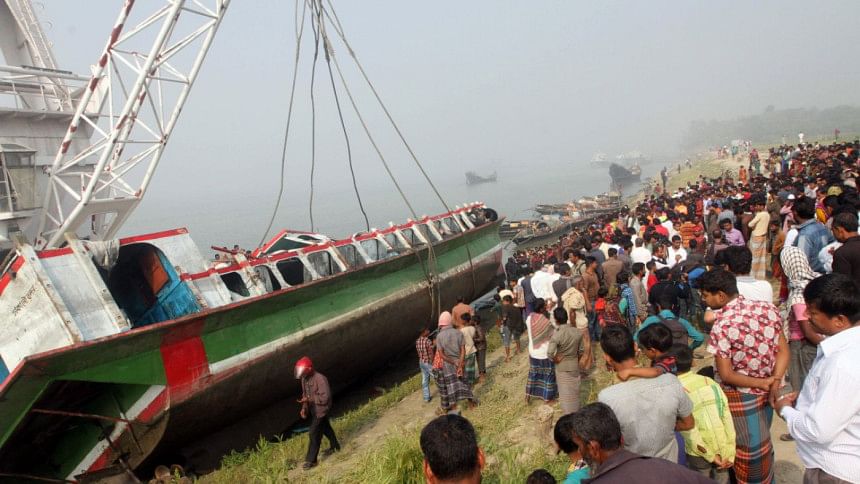LAUNCH DISASTER -- Where lies the remedy?

ON Sunday February 22, M.V. Mostafa, on her way to Daulatdia from Paturia, Manikganj, collided with a cargo vessel and sank instantly in the river Padma in broad daylight with reportedly more than 200 passengers on board. So far, 72 dead bodies have been recovered -- 28 among them from inside the launch.
It is indeed a great human tragedy. It has not only shattered the dreams of those families who have lost their dear and near ones but also compelled the whole nation to think with shock and horror that they are not safe -- at home, on the street, on the river, nowhere.
The government has responded quickly with the salvage operation of the ill-fated launch. It has, as usual, instituted an inquiry committee to find out the causes of the incident and the persons responsible for it. The outcome of such inquiries is anybody's guess.
Launch disaster has become almost a regular feature in this country over the years. Every time such an incident occurs, the television crew and the print media get busy with their coverage. People witness the incidents with shock and horror. Some of us, like me, write articles expressing our deep sorrow, anguish and sympathy.
The minister in charge rushes to the spot and consoles the bereaved families. The department concerned orders inquiry, often by those officials who are directly or indirectly responsible for the incident; gets a report, shifts the responsibility onto others as usual, and shelves it. Nothing happens. With the passage of time, the public forgets the incident until the next one occurs and the authorities concerned also get away from public accountability for their responsibilities, if any.
This is how we dealt with M.V Rajhongshi, which collided head-on with another vessel in the Meghna on December 28, 2000, and sank instantly, leaving more than 200 passengers dead and another 100 or more missing. This is how we dealt with M.V. Mitali, which was caught in a Nor'wester and capsized in the river Buriganga on April 21, 2003 with more than 400 passengers on board.
This is how we dealt with M.V. Prince of Patuakhali, which was caught in a Nor'wester and capsised near Galachipa on May 15, 2005 with nearly 200 passengers on board. The list can go on and on. The story is the same. Each one surpassed the other in terms of loss of life and property.
It is high time somebody did something to put a halt to these unending miseries. Worldwide, river transport is considered to be the safest mode of transport. No wonder one gets confused when one sees the opposite scenario here. It is neither the roaring forties of the southern oceans nor the mighty seas of the Indian Ocean that our river transport system has to negotiate with. It is our rivers, the Padma, the Meghna, the Jamuna, the Buriganga, we are talking about.
If our river transport system cannot ride over the ripples of the calm or relatively calm waters of the Meghna or Jamuna and ensure the safety of life and property of the passengers on board in the 21st century, we had better not talk about the politics of millennium development.
The main causes of launch disasters in our country leading to such colossal loss of life and property have been identified and highlighted by different quarters many a time. These are: (a) faulty design, (b) structural weakness, (c) lack of adequate safety measures, (d) lack of adequate supervision by a competent authority during the construction period, (e) absence of qualified crew, (f) weakness in inspection procedures, (g) obtaining of fitness certificate through unfair means, (h) overloading, (I) disregard to weather forecast, and (j) negligence in duties by the ship's crew.
If, as an old seafarer with 9 years experience in riding the high seas worldwide and working with the Bangladesh inland water transport system for nearly 10 years, I am to identify one single reason, I shall without any hesitation mention that it is the inherent fault in the design and construction of these motor launches that is responsible for the disasters leading to such colossal loss. If I am not wrong, a survey, carried out in the not too distant past, revealed that almost 60% of these motor launches were unfit to ply because they were not built in accordance with the standard practice of shipbuilding.
Nobody can say for sure that the situation is different now. Let us take the case of M.V. Mostafa. The vessel with nearly 200 passengers on board collided with a cargo vessel and sank instantly, leaving 72 dead and others missing. The collision was surely because of either mechanical fault or the negligence of the master or the sareng, or of both.
The instant sinking of the vessel was because of its faulty design and structural failure of its hull. It was broad daylight. The weather was fine. The river was calm. Even if the vessel had collided with the other for one reason or other, it would not have sunk instantly if it was built in accordance with the standard shipbuilding practice. Even if it had sunk, the loss of life would have been minimal had the vessel complied with standard safety requirements.
The writer is a retired merchant navy officer and former Marine Superintendent, BIWTC.
Email: [email protected]

 For all latest news, follow The Daily Star's Google News channel.
For all latest news, follow The Daily Star's Google News channel. 



Comments